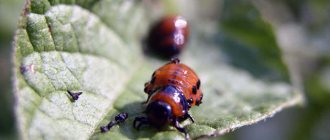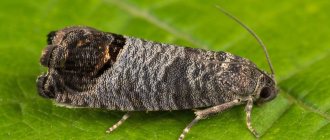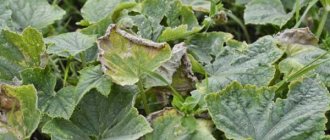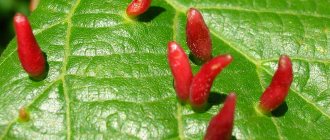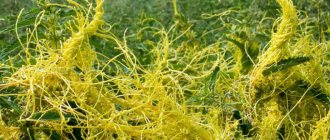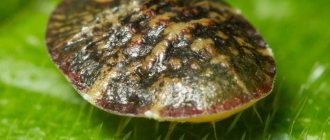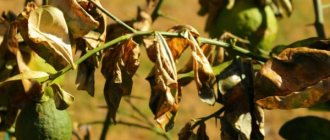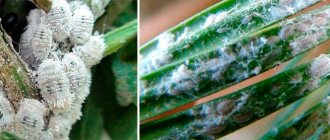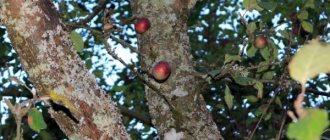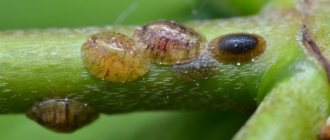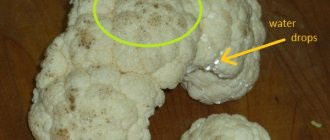Symptoms
The whitefly is a moth-like insect with cream-colored wings and a white or yellow body, no more than 3 mm long. It has 4 wings, the surface of which is covered with a light coating similar to flour. Insect larvae are small, up to 0.3 mm, and look like yellow translucent scales. After birth, they attach themselves to the leaf blade and begin to drink its juice. This is followed by the pupal stage. During this period, the insect is most resistant to chemicals. An adult subsequently emerges from the pupa. She is able to roam and reproduce.
Unpleasant consequences of pest infestation
The consequences of whitefly infestation of cucumbers are not the most pleasant.
- slowing down the growth of the bush;
- decrease in yield;
- drying out of foliage and its gradual fall;
- disruption of the photosynthesis process;
- attracting other diseases, such as fungal and viral infections, or insects such as ants (due to the deposition of honeydew on leaf blades).
Mechanical methods
They are usually used at the earliest stages of the problem. They involve one of the following procedures:
- Manual collection of pests. A sponge is moistened in a soapy solution and the tops are wiped with it. This is how both adults and their young offspring are filmed.
- Removing insects with a powerful jet of water. Finally, the bushes are disinfected with a soap solution (100 g of tar soap per 600 ml of water).
Despite the abundance of modern insecticides, these methods are still used. They do not require large waste and are safe for humans and the environment. There is no need to wait between the procedures and harvesting. You can pick the fruits right away. Among the disadvantages of the method is low efficiency. This way it is possible to remove up to 70% of insects. In addition, the problem often recurs.
What harm does
Whitefly can cause the following tangible harm:
- feeding on sap causes leaves to fall off;
- damages inflorescences and reduces the number of formed fruits;
- releasing a sticky liquid, provokes the development of fungus and the formation of new diseases;
- attracts other pests such as ants;
- leads to drying out of the bush.
Pests can spread to other types of crops and, by laying eggs, increase in number.
Traps
Insect traps can be bought, but many summer residents prefer to make them themselves. To do this, the plastic plate is painted orange. After drying, a layer of entomological glue or a mixture of Vaseline and soap (1:1) is applied to it. A backlight is installed on the plate and the finished trap is suspended above the crop.
There is another way to make a trap. A light bulb with a red light is placed in a small wooden box (if there is none, a regular one is painted). The structure is suspended and a container of water is placed under it. As a result, the butterflies rush towards the light, get burned and fall into the liquid. This way it is possible to destroy about 80% of individuals. A significant drawback of the trap is that it is only effective at night.
Damage to cucumbers
Despite the small size of the butterflies and the even smaller size of their larvae, the damage caused by whiteflies to cucumbers can be very great. This is what happens to cucumbers affected by whitefly:
- when the whitefly sucks out the juice, the plant weakens and its leaves fall off;
- the pest causes damage to inflorescences, resulting in a decrease in the number of ovaries;
- During its life, the butterfly secretes a sticky, sweet liquid, which is colonized by sooty fungus;
- this sweetish liquid attracts other pests, including ants;
- with massive damage, the cucumber bush dries out.
Traditional methods
Homemade infusions and solutions are effective in the initial stages of damage. In advanced cases, they are combined with chemicals. The most commonly used medications are based on:
May be interesting Cucumber Siberian Garland: description and characteristics, reviews Cucumber variety Temp: cultivation, planting and care, photo Cucumber Zozulya f1: description and characteristics, reviews
- Garlic. 3 cloves are crushed and poured with 4 glasses of water, allowed to brew for a day in the dark. The finished product is filtered and the bushes are irrigated with it. Usually after two procedures the number of pests decreases.
- Yarrow. 100 g of fresh raw materials are poured into 1 liter of water at room temperature and allowed to brew for 72 hours. The plants are irrigated with the prepared product three times a month.
- Tobacco. 50 g of tobacco (it can be extracted from strong cigarettes) is poured into 500 ml of boiling water and allowed to brew for 5 days. The bushes are sprayed with it every 3 days until the whitefly on cucumbers disappears completely.
- Dandelion. 80 g of leaves and 40 g of roots are passed through a meat grinder and poured with 2 liters of cold water and allowed to stand for 4 hours. Cucumbers are sprayed with the prepared product once a week.
- Potassium permanganate. A few grains of the substance are dissolved in a bucket of water (it should turn out pale pink). A solution of potassium permanganate is used to irrigate bushes, greenhouses and soil.
- Sahara. 200 g of sugar are diluted in 800 ml of water. Usually one irrigation is enough to eliminate the problem. However, if this is not enough, the procedure is repeated after 7 days. After 5 days, the leaves are washed with clean water.
- Ammonia. 35 ml of ammonia alcohol solution (10%) is diluted in a bucket of water and the bushes are sprayed with the prepared solution every 3 days until the pest completely disappears.
Attention!
The remains of folk remedies cannot be stored and subsequently used. Only fresh medicines can give the desired effect.
How to treat a greenhouse against insects
To prevent the harmful insect from returning next season, the following recommendations must be followed:
- In autumn, all the soil in the greenhouse must be carefully dug up.
- All plants, leaves and branches are removed from the greenhouse and burned.
- In winter, it is necessary to freeze the greenhouse by removing all covers. This method will eliminate the larvae and eggs of all possible pests.
- Treat the greenhouse frame with lime solution, and all other parts with copper sulfate.
All tools and film covering must be processed before a new batch of seedlings is planted in the greenhouse.
Biological agents
Sometimes pests are exterminated by using other insects. For this purpose, ladybugs or lacewings are kept. They hunt for moths and eat them. Also in nature there is an insect that parasitizes whitefly larvae - encarsia. She lays eggs in young moths, causing them to die. They are added to cucumbers in the amount of 20 pieces per 1 m2. However, it is important to take into account that the villi on plants are an obstacle to the encarsia getting to the larvae. Therefore, the method does not always work 100%.
To kill whiteflies on cucumbers in a greenhouse, Verticillin is used. It contains a fungus that is equally dangerous for both larvae and mature individuals. 100 ml of the drug is poured into a bucket of water and the affected parts of the plant are treated with this solution. The procedure is performed three times, maintaining intervals of a week. The advantages of the product include effectiveness and safety. It poses no threat to humans or the environment.
Features of the whitefly life cycle
whitefly belongs to the suborder Aleurodidea of homoptera, similar to microscopic butterflies, proboscis insects - pests of vegetable and ornamental crops, found everywhere in greenhouses, hotbeds and greenhouses. The Latin name comes from the word aleuron - “flour”, since the wings of these “moths” (close relatives of psyllids) are covered with a white coating of powdery pollen. The generally accepted nickname “whiteflies” also reflects the peculiarities of appearance: the presence of two pairs of white wings on a pale yellow body 1-1.5 mm long.
Whitefly larvae (pictured) are sometimes confused with another scourge - aphids
In greenhouse conditions, the lifespan of adults on tomatoes is 14 days, and on cucumbers - 19. Up to 15 generations of the pest can develop in a year, because the biological cycle is 24-40 days.
Over the course of their life (about 30 days), females manage to lay 85-130 eggs on the underside of leaves, in clutches of 10-20 pieces, randomly located or in the form of rings. After literally a few hours, the larva (creeper) emerges from the egg, attaches to the leaf and actively feeds on the plant juices for 10-14 days. Then it is fixed in a stationary state, covered with a waxy substance. After 13-15 days, an adult, voracious individual hatches from it and flies out. In greenhouse conditions they can live year-round, preferring moist and shaded places, and in the spring and summer months the number of pests increases significantly.
Chemicals
In case of significant damage or when other methods of eliminating the pest have failed, chemicals are used. The most effective insecticides include:
- Actellik. The liquid from the bubble is poured into 2 liters of water and irrigation is performed. The procedure is carried out up to two times. The protective effect lasts about 12 days.
- Spark. The tablet is dissolved in 10 liters of water. If necessary, plants are sprayed again after 20 days.
- Confidor. 1 ml is dripped into 5 liters of water. The effect lasts from 2 weeks to a month.
- Aktara. 3 g of powder is poured into a bucket of water and stirred. The protection period lasts 15-30 days. When watering at the root, the dose of the drug per bucket of water is 8 g. In this case, the protection is extended to 45-60 days. Product consumption – 1 liter per 1 m2.
- Arrivo. 1.5 ml of the product is diluted in a bucket of water. Protection lasts 2 weeks.
- Bona Forte. The liquid from the ampoule is poured into 500 ml of water. The drug protects against the pest for 15-20 days.
- Inta-Vir. Consumption: 1 tablet per bucket of water. To eliminate the problem, it is enough to spray the bushes 1-3 times.
- Talstar. 0.6 ml per 1 liter of water. The effect of the product lasts for 15-20 days.
- Tanrek. Pour 1 liter of water into a plastic container, add 2.5 liters of the drug, stir and add another 4 liters of liquid. The duration of the effect is a month.
- Karbofos. Dosage: 1 ml per 1 liter of water. This amount is enough for 1 m2 of land.
Reviews
All these methods have been repeatedly tested by gardeners who have at least once fought against whiteflies. Not every method bears fruit, and sometimes new solutions appear that unexpectedly lead to victory.
Galina, Kazan: “What if you use a sulfur bomb to treat a greenhouse? Every autumn I light 3 checkers at the same time (I have a large greenhouse). And in the summer I make tobacco smoke in the greenhouse - it doesn’t harm the plants, but the effect is excellent! There are no whiteflies..."
Tatyana, Voronezh region: “ Last year I was in a greenhouse in the summer, but I couldn’t destroy it. In winter I kept the greenhouse without snow; I added snow only in February. I didn’t see it in the greenhouse this summer. So it’s not all that bad.”
Natalya, Perm: “I only had whiteflies in the first year of my gardening. Then I started hanging up bottles of iodine - there were no pests or late blight.”
Margarita, Tyumen: “ I’m militantly determined for the summer of 2021! I've been on the warpath since the fall! First of all, I treated the diseased (and not only) bushes behind closed doors. The next day I dug up all the bushes, took them far beyond the site and burned them! I dug up the ridges when it got cold and didn’t cover them with snow. I wanted to freeze this disgusting thing, but it’s not for nothing that they say - be afraid of your wishes! The winter turned out to be fierce: 10–15 centimeters of snow fell during the entire winter, and the frost was -50! Not only the whitefly froze - 90% of the perennial flowers, almost all the vegetables in the cellar. So I won this war at the cost of great losses, but there were no whiteflies in my greenhouse in the summer of 2021!”
Yuri, Chelyabinsk: “I struggled for six months, all to no avail, nothing helps. The fumigator (Transflutrin liquid) unexpectedly helped. All those flying died within a day. It does not affect larvae and eggs, you need to wait until the butterflies hatch. We close the greenhouse tightly, turn on the fumigator in the evening (at night), turn it off in the morning, repeat every other day, and so on for a month (preferably two). The effect is 100%.”
